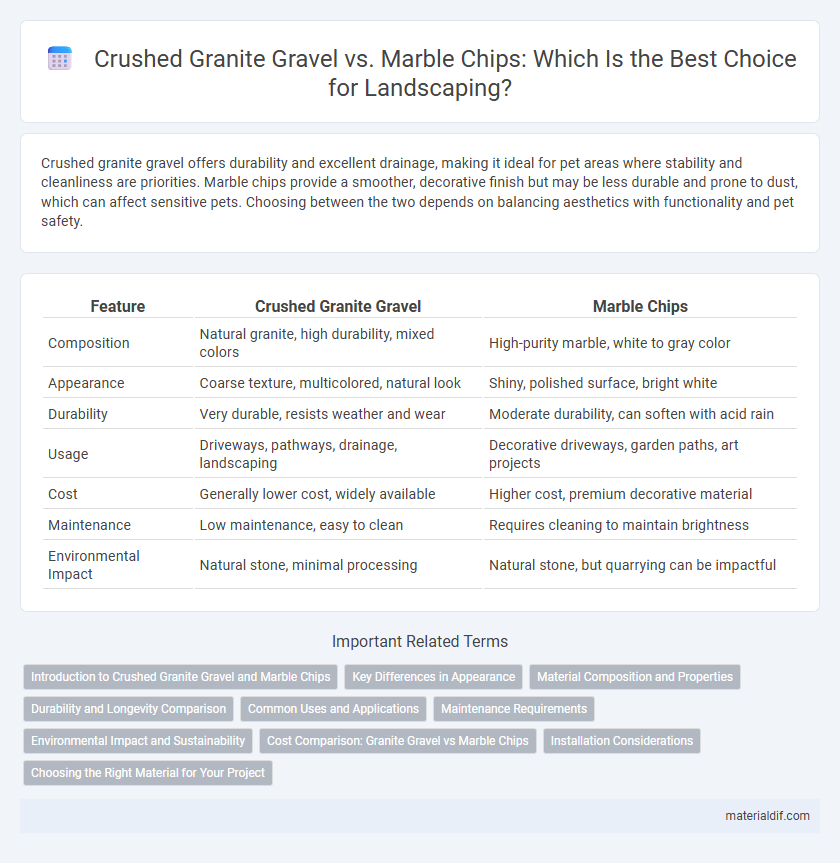Crushed granite gravel offers durability and excellent drainage, making it ideal for pet areas where stability and cleanliness are priorities. Marble chips provide a smoother, decorative finish but may be less durable and prone to dust, which can affect sensitive pets. Choosing between the two depends on balancing aesthetics with functionality and pet safety.
Table of Comparison
| Feature | Crushed Granite Gravel | Marble Chips |
|---|---|---|
| Composition | Natural granite, high durability, mixed colors | High-purity marble, white to gray color |
| Appearance | Coarse texture, multicolored, natural look | Shiny, polished surface, bright white |
| Durability | Very durable, resists weather and wear | Moderate durability, can soften with acid rain |
| Usage | Driveways, pathways, drainage, landscaping | Decorative driveways, garden paths, art projects |
| Cost | Generally lower cost, widely available | Higher cost, premium decorative material |
| Maintenance | Low maintenance, easy to clean | Requires cleaning to maintain brightness |
| Environmental Impact | Natural stone, minimal processing | Natural stone, but quarrying can be impactful |
Introduction to Crushed Granite Gravel and Marble Chips
Crushed granite gravel consists of angular, coarse particles derived from granite rock, known for its durability and natural appearance in landscaping and construction projects. Marble chips, formed from crushed marble stone, offer a smooth texture and reflective quality, making them popular for decorative pathways and garden accents. Both materials provide unique aesthetic and functional benefits depending on the desired application and environmental conditions.
Key Differences in Appearance
Crushed granite gravel features a rough texture with angular edges and a mix of gray, pink, and black hues, offering a more natural, rugged look. Marble chips display a smooth, polished surface in bright white or light pastel colors, providing a clean, elegant appearance. These distinct visual characteristics influence their choice for landscaping, driveways, and decorative projects.
Material Composition and Properties
Crushed granite gravel is composed primarily of durable granite, featuring a rough texture and high compressive strength suitable for heavy-duty applications. Marble chips consist mostly of calcium carbonate, providing a smoother surface and a lighter color but lower durability compared to granite. The mineralogy of granite offers better resistance to weathering and wear, making granite gravel preferable for structural uses while marble chips are often chosen for decorative landscaping.
Durability and Longevity Comparison
Crushed granite gravel offers superior durability and longevity compared to marble chips due to its dense composition and resistance to weathering and erosion. Granite's hardness withstands heavy traffic and harsh environmental conditions without significant wear, making it ideal for long-term projects such as driveways and pathways. Marble chips, while aesthetically appealing, tend to degrade faster under similar conditions because of their softer mineral structure and susceptibility to acidic damage.
Common Uses and Applications
Crushed granite gravel is commonly used for driveways, pathways, and drainage systems due to its durability and excellent compaction properties. Marble chips are favored in landscaping and decorative applications such as garden beds, walkways, and water features for their bright, reflective appearance. Both materials serve practical and aesthetic roles but are selected based on specific project requirements like load-bearing needs or visual appeal.
Maintenance Requirements
Crushed granite gravel demands minimal maintenance due to its durability and resistance to weathering, making it ideal for driveways and walkways that experience heavy traffic. Marble chips require more frequent upkeep because they are softer, prone to chipping, and can discolor over time from exposure to moisture and sunlight. Regular cleaning and occasional replenishment are essential for marble chips to maintain their aesthetic appeal and structural integrity.
Environmental Impact and Sustainability
Crushed granite gravel has a lower environmental impact compared to marble chips due to its abundant availability and less intensive quarrying process, which reduces habitat disruption and energy consumption. Marble chips often require more energy-intensive extraction and processing, contributing to higher carbon emissions and resource depletion. Choosing crushed granite gravel supports greater sustainability by minimizing ecological disturbance and promoting the use of naturally resilient materials.
Cost Comparison: Granite Gravel vs Marble Chips
Crushed granite gravel typically costs between $40 and $65 per ton, making it a budget-friendly option for landscaping and driveways. Marble chips, on the other hand, are generally priced higher, ranging from $50 to $100 per ton due to their polished appearance and decorative appeal. Cost efficiency favors granite gravel for large-scale projects, while marble chips are preferred for accent areas where aesthetics justify the premium.
Installation Considerations
Crushed granite gravel offers superior drainage and compaction, making it ideal for pathways and driveways requiring stability and easy water runoff. Marble chips, while aesthetically appealing, tend to be smoother and can become slippery when wet, posing challenges for safe installation in high-traffic areas. Proper base preparation is essential for both materials, but crushed granite gravel generally requires less maintenance and settling time compared to marble chips.
Choosing the Right Material for Your Project
Crushed granite gravel offers superior durability and drainage, making it ideal for driveways and pathways, while marble chips provide a polished aesthetic suitable for decorative landscaping and garden beds. Granite's angular edges create better interlocking for stable surfaces, whereas marble chips, composed of calcite, may be prone to weathering in acidic conditions. Selecting the right material depends on your project's functional requirements and desired visual impact, with granite favored for structural projects and marble chosen for ornamental purposes.
Crushed Granite Gravel vs Marble Chips Infographic

 materialdif.com
materialdif.com